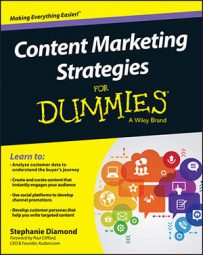To understand how the pieces of a content marketing strategy fit together, organize the components into a framework called the Five Cs. They are (1) company focus; (2) customer experience; (3); channel promotion (4) content creation, and (5) check-back analysis.
Working with the Five Cs framework helps you cover all the bases as you create your content marketing strategy and implement your content plan.
Determining the company focus
The first C is company focus. To create a content marketing strategy, you need to begin by looking at your company's business goals. The question to ask yourself and your team is, "What do we want the company to achieve and how do we make it happen?"
You should direct your attention to your goals and business case for undertaking this effort:
Components that go into creating a content marketing strategy
Getting your customers' attention: Content marketers are fiercely competing for your customers' attention. Find out why attention is important and how to capture it.
Understanding your business model and your brand: Learn about a variety of business models and how to determine what "job" your product does. You look at brand components and access a downloadable brand worksheet to use.
Getting buy-in from your teams: Getting buy-in from everyone on your team, not just the executives, is important.
Putting your content marketing plan together: Find out how the organization of your company can affect the success of your content marketing efforts.
Uncovering the customer experience
The second of the Five Cs is customer experience. You need to learn what your prospects will think, feel, and do when interacting with your brand. The question for your marketing team to ask is, "Who are our prospects and how will we serve them as customers?"
You must define your audience and analyze the customer experience. You do this by
Collecting and analyzing customer data: Before you define your audience, you need to evaluate the kind of data you will use.
Creating personas: Define the characteristics of your perfect audience by investigating several different types of information.
Developing the customer journey: You want to understand the journey your prospect takes from being interested in your product to sold on it.
Assisting with sales enablement: Your sales team is facing an empowered customer.
Creating quality content
The third C is content creation. You need to focus on creating quality content (based on your story) that you know your customers want and need. The question to ask is, "How will we create quality content, who will do it, and what will that content be?"
You need to develop a strategy for content, define your messaging, and establish your systems and governance rules.
Creating a content strategy: You should have both a content plan and a content marketing strategy.
Content types: You want to ensure that you take full advantage of all the types of content available to you.
Writing and storytelling: You have a story to tell that will connect with your audience. How do you incorporate it into your content?
Processes and systems: You know that without a documented workflow and procedures, your content marketing efforts fail.
Developing channel promotions
The fourth C is channel promotion. To have your content make the greatest impact, you want to decide where and by whom your content will be distributed. The question to ask is, "How will our prospects and customers find our content so that they can choose us?"
You want to make your content easy to find and share. You need to know how to promote your content so that prospects can find it.
Channel plans: Developing a content plan is not enough. After you have created your content, you need to get wide distribution.
Sharing content: Sharing is key to any content plan. Embrace share-ability as a strategy and borrow from journalism's Five Ws and one H (who, what, why, where, when, how) as applied to sharing.
Paid, earned, shared, and owned media: Making the most of all types of media is the only way to ensure that your brand voice will be heard.
Syndication and guest posting: Do you think syndication is "old school"? Maybe it's not.
Influencers: Influencers wield a great deal of power with online audiences.
Deploying check-back analysis
The fifth C is check-back analysis. The focus here is on the metrics you choose to determine successes or failure. The question to ask is, "Have we met our goals?"
You want to reevaluate your plans and make revisions as necessary. You want to
Reassess your business model and brand value: You know that it's important to frequently assess how things are working. Find out how you can determine whether business model changes are warranted and whether you need to revise brand plans.
Reexamine your content marketing strategy: Obviously, a determination of how well your content marketing strategy is working is essential. See why even failing is a springboard to success and why you need to get buy-in for making changes.

